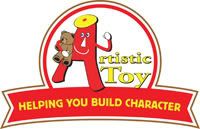Discount cards, candles, chocolate bars, cookie dough, entertainment books, magazines, and scratch cards. Been there, done that. And gaining profit from these goods means initially buying more products at cheaper bulk-prices and trying to sell them all for greater return. Wouldn’t it be better if the product was unique and generated more return on its own?
Fundraising Step One: the mascot.
Schools are identified by their mascot, such as the Buckeyes or the Scarlet Knights. Almost every school has a mascot that is displayed on sports jerseys, school banners, school apparel, and might even be a “live” costume mascot. What about using them for fundraisers too?
Plush toy mascots could not only generate profit for the school’s organization but also generate school spirit. Chocolate bars and discount coupons have no association to the school – customers may forget about that candy bar that was so quickly consumed, the useless wrapper that was thrown away, and the cause for which those few dollars were spent. Plush toy mascots are directly connected to the school, especially when accompanied with t-shirts that display the school’s logo or event that is being fundraised. So customers are getting a product that promotes the school’s activities as well as the school itself.
Consider a school whose mascot is the bulldog. Say the distributer buys 100 plush bulldogs, which will cost the distributor about $5 each. That equals $500 as the initial cost for this fundraiser. To generate profit, they might sell these bulldogs for $10. That’s 10x100 = $1000, which means $500 profit. For even more profit, the school could either sell more or increase the customer purchase price. Or they could read on…
Fundraising Step Two: extra effort = extra return.
Want to put in a little more oomph into the fundraising process? The results will prove to be well worth the extra effort.
I want to introduce a new idea for those same plush toys… the Interactive Plush Toy: Add a tag on each of the toys and you now have a mascot plush toy, a t-shirt with the school’s logo, and a tag that is redeemable for discounts at participating local businesses.
Extra effort: Organizers of the fundraiser will need to recruit some local businesses to be a part of their fundraising event. The tags on the mascots will be redeemable at one of the participating local businesses. The prize could be a free slice of pizza or 50% entrée at a new restaurant – whatever the businesses have agreed to offer.
Extra return: The customer is getting a toy and a discount offer at a local business. The event’s fundraising profit increases. The involved businesses are getting increased traffic at the cost of, say, just a few slices. Everyone profits!
Of course, with this new added feature, the mascots can be sold at a higher price.
The bulldogs will still cost $10 for the school ($500 initial website cost) if the school buys 100 toys. However, now sell the little mascots for $25, which adds up to 25x100 = $2500. That means $1500 profit. You just increased the return of your fundraiser! Now, why not go a little further?
Fundraising Step Three: 100% no cost to you.
Get a business to fully sponsor your fundraiser. Their logo can go on the t-shirt: “Sponsored by…” The local business will pay the initial costs of the mascots and on-line redemption program. In the case of the bulldogs, that’s $500 + $500 for website. All the t-shirts will have an advertisement of the business, and a portion of the tags (whatever percentage the business approves) will be redeemable at that location.
The cost for you is $0. The profit for you is 20x100= $2,000. The profit for the promoted business is increased traffic via the tags and increased awareness via the t-shirt ad space. Sounds like a win-win situation.
Wednesday, August 6, 2008
Build a Powerful School Fundraiser Program
Subscribe to:
Post Comments (Atom)






No comments:
Post a Comment